![]()
![]()
![]()
Use LEFT and RIGHT arrow keys to navigate between flashcards;
Use UP and DOWN arrow keys to flip the card;
H to show hint;
A reads text to speech;
19 Cards in this Set
- Front
- Back
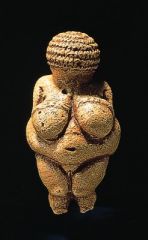
|
Title of Work: Nude woman (Venus of Willendorf)
Origin: Willendorf, Austria Date: ca. 28,000-25,000 BCE Culture/period: paleolithic Medium: Limestone Purpose: focus on representation of women; women able to bear a child ensured survival of species. Aesthetic: Exaggerated features (not naturalism), no facial, pubic triangle |
|
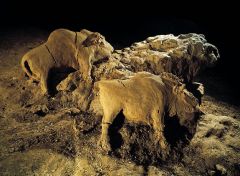
|
Title of Work: Two bison reliefs
Origin: Le Tuc d'Audoubert, France Date: ca. 15,000-10,000 BCE Culture/period: paleolithic Medium: clay Description: Against freestanding rock. 2 feet long each - largest paleo sculptures. Clay brought from elsewhere in the cave. |
|
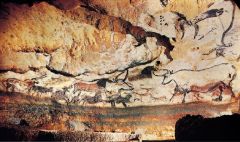
|
Title of Work: Hall of Bulls
Origin: Lascaux, France Date: ca. 15,000-13,000 BCE Culture/period: paleolithic Medium: cave painting Description: Many of the bulls are coloured silhouettes, others outline alone. The differences in style suggest animals painted at different times. Twisted perspective/composite view |
|
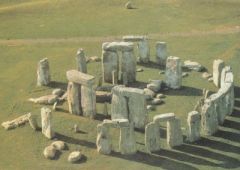
|
Title of Work: Stonehenge
Origin: Salisbury Plain, England Date: ca. 2550-1600 BCE Culture/period: Neolithic Medium: stone, megalithic Description: built over 100's of yrs. post-and-lintel. astronomical observatory and solar calendar. Stones were put into place by pulling system. lines up with sun and moon. Originally a funerary site for cremation, then observatory and centre for healing/sick. |
|
|
Paleolithic
|
30,000-9,000 BCE
The "old" Stone Age, during which humankind produced the first sculptures and paintings. Tools makindg and imagery. |
|
|
Neolithic
|
The "new" Stone Age. Domestication of animals and crops.
|
|
|
composite view/twisted perspective
|
A convention of representation in which part of a figure is shown in profile and another part of the same figure is shown frontally.
|
|
|
sculpture in the round
|
A sculpture that is sculpted on all sides, intended to be seen from all angles.
|
|
|
relief sculpture
|
In sculpture, figures projecting from a background of which they are part. The degree of relief is designated high, low (bas), or sunken. In the last, the artist cuts the design into the surface so that the highest projecting parts of the image are no higher than the surface itself.
|
|
|
post-and-lintel
|
A system of construction in which two posts support a lintel.
|
|
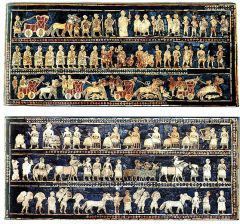
|
Title of Work: Standard of Ur
Origin: Royal Cemetery, Ur(Tell Muqayyar), Iraq Date: ca. 2600 BCE Culture/period: Sumerian Medium: wood inlaid with shell, lapis lazuli, and red limestone Description: beakers could be a sign of offerings being made. First historic culture with the wheel. war side and peace side/narrative top to bottom. |
|

|
Title of Work: Victory stele of Naram-Sin
Origin: Susa, Iran /Sippar Date: ca. 2254-2218 BCE Culture/period: Akkadian Medium: Pink Sandstone Description: conquered the sumerians and took over their land.first narrative, the lullubi people were defeated by naram sin and his men. The stars above are gods in native form. First time king appears as god in Mesopotamian art. |
|
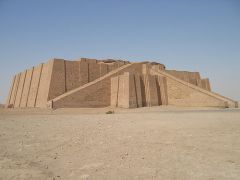
|
Title of Work: Ziggurat of Ur
Origin: Tell Muqayyar, Iraq Date: ca. 2100 BCE Culture: period: neo-Sumerian Medium: mud brick (baked bricks) w/ bitumen Description: largest monument temple of its kind. 50' high. restored. |
|
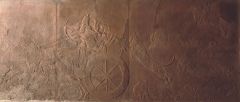
|
Title of Work: Ashurbanipal hunting lions
Origin: the North Palace of Ashurbanipal, Kuyunjik (Nineveh), Iraq Date: ca. 645-640 BCE Culture/period: Assyrian Medium: gypsum - manly royal virtues - victory in warfare king of men besting king of beasts |
|
|
stele
|
A carved stone slab used to mark graves or to commemorate historical events.
|
|
|
ziggurat
|
In ancient Mesopotamian architecture, a monumental platform for a temple.
|
|
|
registers/friezes
|
One of a series of superimposed bands of friezes in a pictorial narrative, or the particular levels on which motifs are placed/any sculptured or painted band in a building.
|
|
|
hierarchy of scale
|
An artistic convention in which greater size indicates greater importance.
|
|
|
apadana
|
The great audience hall in ancient Persian palaces.
|

